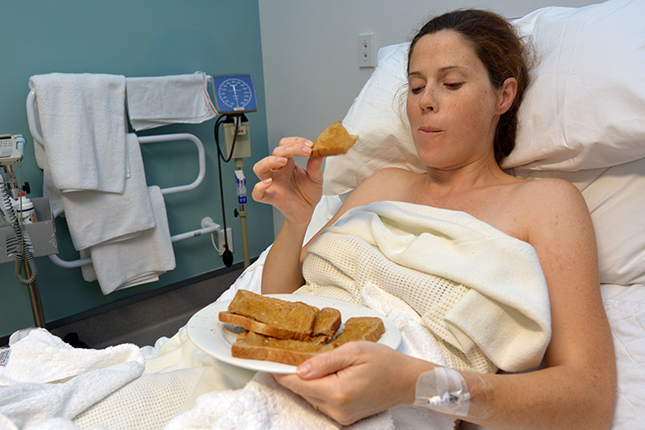The Preggie Pals
Eating While in Labor
[00:00:00]
Please be advised, this transcription was performed from a company independent of New Mommy Media, LLC. As such, translation was required which may alter the accuracy of the transcription.
[Theme Music]
STEPHANIE GLOVER: For years modern medicine has claimed that eating during labor can be dangerous to mom and baby. Most women in North America are at least somewhat restricted with food and beverage intake during labor particularly in the hospital setting.
A new study presented by the American Society of Anesthesiologist now shows: “Most healthy women would benefit from a light meal during labor.” Find out why today on Preggie Pals.
[Intro/Theme Music]
STEPHANIE GLOVER: Welcome to Preggie Pals, broadcasting from the Birth Education Center in San Diego. Preggie Pals is your online, on the go support group for expecting parents and those hoping to become pregnant. I’m your host Stephanie Glover. We’ve covered topics for every phase of pregnancy. Visit the episode guide on our website to scroll through those topics.
Listen directly on your computer through iTunes or download our free apps available on Android, iTunes and the Windows Marketplace. Be sure to check out our new network app where you can listen to all your favorite New Mommy Media Shows on-the-go. Here’s Sunny with more information about how you can get involved with Preggie Pals.
SUNNY GAULT: So we are in the process now of planning out our episodes for 2016 and we would love to have some suggestions on episodes and topics that you guys are most interested in. We’ve done over a 130 episodes on Preggie Pals. So as you can imagine that the conversations – well okay, what haven’t we covered yet? All right, what do we need to do now?
So if you have ideas of something that you would like us to cover, please let us know. You can send us an e-mail. We also have different segments that you as pregnant mamas can participate in. It’s just a way for us to get you involved with the show. So we’ve got the segment called, “Pregnancy Oops” where you can share your funny pregnancy stories. We have an, “Ask the Experts” segment where you can call in to our team of experts and ask them your pregnancy-related questions and we can get those answered for you.
We just like to get mail from you guys – not mail like delivery mail. That’s a little old school for us. We’re talking about e-mail here right? So if you e-mail us and just let us know if you have any comments about the show or if you have any suggestions, we just want to hear from you guys. It’s a nice way for us to connect with all of our listeners.
So again, if you want to submit for anything, you can go to the contact link on our website at www.NewMommyMedia.com. You can also submit via voice mail so you can call us at 619-866-4775 and let us know what’s up. We hope to hear from you soon.
STEPHANIE GLOVER: Great! Thank you Sunny!
SUNNY GAULT: Yes.
STEPHANIE GLOVER: So let’s get to know the panelists. Go ahead and I’ll introduce myself first. So I’m Stephanie Glover. I am the host of Preggie Pals. I am also a trained child birth educator and mom of two. My daughter Gretchen is four and she was my C-Section baby. My daughter Lydia is two and she was my VBAC.
SHANNON CEBALLOS: Hi. My name is Shannon, I am 31. I’m a stay-at-home mother to two children. Emerson will be four months next week and Gabriella will be two later on this month. Both of my kids are C Sections.
SUNNY GAULT: I’m Sunny. I’m producing today’s show. I have four kids of my own ages five, three and then I have twins that just turned two.
[Theme Music]
JENNIFER DURBIN: Hi. I’m Jennifer Durbin, the author of Pregnancy Tips for the Clueless Chick and a mother of two wonderful little boys. I’ve got some great tips for you for planning your maternity leave. Believe it or not, it’s never too early to start planning your maternity leave. If you plan to go back to work, you’ll want to start thinking about daycare sooner rather than later.
In some cities, you may need to register your little one for daycare when you’re only 12 weeks pregnant – so plan ahead. Before you let your boss know that you’re expecting, it’s a good idea to have your maternity leave planned all worked out. So start reading your company’s leave policies including short-term disability and look and see (FMLA) the Family Medical Leave Act.
Your HR Department or a trusted co-worker who’s taken maternity leave are other fabulous resources. When you talk to your boss, he/she will likely want to know when you’re due, how long you plan to be on maternity leave and if you’ll be returning to your current work schedule. So make sure you and your partner have worked through all of these details beforehand.
But keep in mind, once you hold that little bundle of joy in your arms, all of your carefully laid plans maybe thrown right out the window. If you do decide to go back to work, don’t underestimate how challenging your transition back maybe. Not only will you’d be readjusting to work, you’ll also be adjusting to your baby’s new child care routine. You should also keep in mind that your first week back at the office will be very draining. So it’s a good idea to plan to take Friday off to recoup.
The worst thing you can do is, “Run yourself like you’re trying to do everything” so plan for that extra day of vacation. You can also save yourself a bit of transition stress by having the little ones daycare the week before you go back to work. That way you have plenty of time to ease in to your new normal. But most importantly, take into consideration the financial implications of your plan so that you’re fully prepared for what lies ahead. For more great tips, visit www.CluelessChick.com.
[Theme Music]
STEPHANIE GLOVER: Today Michael Bautista joins us on the phone from St. John’s Newfoundland, Canada as our expert. Dr. Bautista was the co-author of the new study that was presented at the American Society of Anesthesiologist meeting in San Diego. He is also the associate professor of faculty of medicine at Memorial University of Newfoundland. Welcome to Preggie Pals Dr. Bautista.
MICHAEL BAUTISTA: Well, thank you very much.
STEPHANIE GLOVER: So many expectant parents may not even realize that in many cases mom might be discouraged to eat while in labor. So can you shed some light on how this fasting practice even came about?
MICHAEL BAUTISTA: Well sure. Well, it goes back to 1946 when a fellow Mendelson elucidate in the cause of aspiration during general anesthesia for caesarian section as being inhaling stomach contents into the lungs while the moms where under anesthetic.
Since that time, there’s been a very justifiable concern for this very dangerous and possibly deadly condition. That’s what moms have been told to fast in labor so that their stomachs would be empty in case if they needed urgent surgery.
STEPHANIE GLOVER: So we know that there was the chance of aspiration. Was that a high risk when he had done that study?
MICHAEL BAUTISTA: I don’t have the numbers with me. But it wasn’t the majority of them. But I think it would have been – let’s see if I can find this.
STEPHANIE GLOVER: Well, no worries. I mean it wasn’t a super high risk but it was certainly there and enough to address.
MICHAEL BAUTISTA: Yes, that’s right.
STEPHANIE GLOVER: Okay.
MICHAEL BAUTISTA: Because of the treatment at the time, it would have been more likely to result in death and it would be with our modern medicine today. So it was quite a dangerous complication.
STEPHANIE GLOVER: Right. So can you tell us about today’s risk and how is it change since then?
MICHAEL BAUTISTA: Well, actually the risks for aspiration and the causation of it in women’s stomach haven’t change since 69 years. So the risks are still there. However, those risks are understanding of labor and the management of labor and the mention of those risks has changed over the past 69 years. So I guess it’s a management problem.
From our review of the literature, we looked at the two key areas with regards to risks of aspiration that is the volume and the acidity of the stomach contents during labor; as well as the difficulty of inserting the breathing tube into the wind pipe of the mom after starting of anesthesia. We’ve been able to sort of modify and change our needs for a general anesthesia and modify the stomach contents of mothers in labor.
STEPHANIE GLOVER: Now panelists, had you been aware of these restrictions for that you might not be able to eat or drink in labor? Did you know that going into labor and delivery?
SHANNON CEBALLOS: No, absolutely. Yes, that was one of the main reasons my midwife’s told me. Stay home as long as possible and you know try and have light meals because if you end up going to the hospital, they’re going to restrict what you can eat.
Just in case you end up having a C Section and being that, I had a C Section with both kids. When I ended up at the hospital with Emerson for example, it was 6:00 AM and I had not eaten yet. I was there because I had fallen down the stairs and I was 39 weeks pregnant.
So we got there and I was like: “Hey. Order some breakfast, let’s get that under way.” My doctor came in and he’s like: “Actually, no.” So I was like: “Let’s get the C Section started because I’m hungry.”
SUNNY GAULT: Mama wants to eat.
SHANNON CEBALLOS: I am ready to eat.
STEPHANIE GLOVER: Sunny, how about you? Was that something that you knew going into that you might not be able to eat or drink?
SUNNY GAULT: Yes, I did. Yes, I definitely did. With my first child, we were going for vaginal birth. There was no reason to do otherwise. I definitely wanted to try the vaginal birth. So I remember trying to eat as much as I could going to the hospital because I knew once I got there that they were going to ice chip me. Actually, hospitals have really good ice chips.
STEPHANIE GLOVER: They do. They do but trying to eat them as a meal when you want a turkey sandwich
SUNNY GAULT: Right, exactly! Exactly! Then, I also knew too. So my first baby was and ended up being a vaginal birth and everything was fine. Then so at my second baby I knew it was a plan caesarian. So I got the whole run through for all of my doctors. Before, don’t eat after this blah-blah-blah.
STEPHANIE GLOVER: Right.
SUNNY GAULT: It turned out to be pretty much by-the-book caesarian. So I never went into labor, nothing like that. Everything turned out fine. I knew what to expect with that. With my twins, it was a plan caesarian but they decided: “Baby A decided to break her water three weeks before my planned caesarian.”
STEPHANIE GLOVER: Right.
SUNNY GAULT: So I ended up going into labor. So definitely varied amounts of food here and there when I had more time to prepare as when I was hungriest the most because I had to get those cut off marks.
STEPHANIE GLOVER: Right. Yes because it’s looming.
SUNNY GAULT: Exactly.
STEPHANIE GLOVER: Well and that’s actually a great segway because you know Dr. Bautista, one thing as a child birth educator and as Shannon mentioned her midwife advise her to have a light meal in early labor.
It’s almost contradictory because some maybe encouraging laboring women to get some food in. But then, otherwise they’re told at their birthing place, not to eat. So I’m wondering if you could just talk a little bit about that and how come, where is that differential I guess.
MICHAEL BAUTISTA: Let’s see that’s the most contentious issue. That’s what causes the greatest debate with regards to anesthesia and labor etcetera. So where you put that line when you can’t eat and when you can eat is I guess the whole crux of the study that we did. We, anesthesiologists just don’t like taking any risks. So the question center around that risk is, “If we let this woman eat during her labor, will we be putting her at risk for aspiration if she would have an operative delivery?”
So the key question here then is to: “Decide who is low-risk for that.” That is the key question and that has to be, there has to be some way of deciding. So if you are to anticipate that a woman was going to have a normal vaginal delivery that you would have anticipated that there would be no problems with anesthesia should that be required – this would be a person that you would consider low-risk for having something to eat during early labor.
So if that person say were to transition into a high-risk category, perhaps there’s something wrong with the fetal heart where there’s not adequate progress during labor – then one would have to re-visit that decision should an eating policy be in place. But if you were to leave it to the mom, I gather that most women around four to five centimeters lose their appetite anyway. Now they remain thirsty.
I believe that most jurisdictions would allow women to have clear fluids during labor. So that’s where that would continue. But when you draw that line, I guess it’s a very artificial that once you cross the threshold going into the hospital that you have to fast. I think that’s where our study is going to be able to cause some debate and discussion because I don’t know if there has been much discussion about this particular aspect of labor in a long time.
STEPHANIE GLOVER: It’s interesting that you mentioned: “Appetite” and “Four to five centimeters” because I don’t know. Sunny, do you know how dilated you got when you’re in?
SUNNY GAULT: Well, once I had my epidural, I do think that it kind of – I wasn’t as hungry for whatever reason. Maybe I’m not really sure why.
STEPHANIE GLOVER: Maybe you couldn’t feel your stomach?
SUNNY GAULT: I kind of feel my stomach ached.
STEPHANIE GLOVER: Because I didn’t feel anything with my first epidural.
SUNNY GAULT: You know it wasn’t until after the baby was born when I started gain feeling that I became ravenous like where is my food? So I’m not sure really at what point.
STEPHANIE GLOVER: Yes because when I went into that labor with my first, I went to my OB before because I said: “I feel funny.” She said: “Let me check you.” I was four centimeters. I remember thinking in my mind: “I need to eat.” There was like a deli in that same complex. I have to, I have to eat. Being so, it was like this kind of combo of nervousness, anxiousness and excitement.
SUNNY GAULT: Yes.
STEPHANIE GLOVER: That I just didn’t have an appetite. I think I picked up a yogurt and a Gatorade and shove it in my purse just in case. But I couldn’t even eat then because you’re like: “This is my first baby. My gosh! I’m having the baby right now.” Yes. What I did later, we’ll discuss then. I might not have been the best patient at the hospital. But then, my second labor, I was essentially was just in transition when I woke up. So I’m not hungry at all.
SUNNY GAULT: My gosh!
STEPHANIE GLOVER: Yes.
MICHAEL BAUTISTA: Yes, I think that most mothers – I don’t know within the epidural that you see most women will have their epidural at four to five centimeters. So your appetite might have been on the waiting even without the epidural. That’s a common place for the quest for epidural in my experience.
So the type of food that one would eat would have to take into account for that. So if at the end of the debate and the discussion over whether-or-not policy should change, you’ll have to definitely be some discussions around what kinds of foods would this be. I would say that yogurt and Gatorade is probably what moms like then. It doesn’t seem most people are looking for pizza or fried chicken.
SUNNY GAULT: Hamburger.
STEPHANIE GLOVER: Right.
MICHAEL BAUTISTA: It doesn’t seem to be high on their want list anyway. These sorts of foods would really slow down the ability of the stomach to empty into the lower intestinal track. So luckily, I think most women don’t want that stuff.
STEPHANIE GLOVER: Right. I think your body guides you to what you need anyway and most of those are . . .
MICHAEL BAUTISTA: Yes, I think so too.
STEPHANIE GLOVER: Okay. So when we come back, we’ll discuss risk factors further as well as potential benefits to eating and drinking in labor. We will be right back.
[Theme Music]
STEPHANIE GLOVER: Welcome back. Today we’re discussing: “The risks and benefits of eating while in labor.” Dr. Michael Bautista, associate professor at the faculty of medicine at Memorial University of Newfoundland is joining us on the phone today as our expert.
Dr. Bautista, you were starting to mention the different food types and what would not be very great for the woman’s stomach, acid and just kind of in general heaviness of like fried chicken or maybe a giant meat loaf or something while in labor. How I went towards the Gatorade and the yogurt, what would be some other maybe beneficial light foods for a low risk laboring woman?
MICHAEL BAUTISTA: Well, if policies were to change
STEPHANIE GLOVER: Right.
MICHAEL BAUTISTA: Our study didn’t look at this. In fact, it’s a question that we didn’t anticipate. But sort of for the purposes of this and the immediate release for the meeting, we found that: “Other places will highlight low-fat, low-residue food.” So that would be things like toast and jam or yogurt or fruit juices that sort of thing and nothing too heavy.
I don’t think that would be out-of-keeping of what many women in labor would want. They don’t want anything too heavy. They want something to keep them going.
STEPHANIE GLOVER: Right.
MICHAEL BAUTISTA: So not having been in labor myself, I’m not sure.
STEPHANIE GLOVER: No?
MICHAEL BAUTISTA: That would seem to be what would be appropriate from what I’ve been told by midwives in that sort of thing.
STEPHANIE GLOVER: Right. Reviewing some other information on the study and just the topic in general being an educator, it’s often compared to a marathon runner.
MICHAEL BAUTISTA: That’s correct.
STEPHANIE GLOVER: There are calories that are needed to sort to keep your body going. I’m actually curious from the panelists; did you hit points of exhaustion? Did you hit points where you maybe thought, “If I had a little bit more fuel, would this have helped?” I don’t know. I mean every labor so different. So I’m just wondering if you guys have any thoughts on that.
SHANNON CEBALLOS: I remember being full. So I had my C Section. So with my Bree, they were inducing me. It took three days for them to be like, “Okay. You’re not progressing. Your blood pressure hasn’t lowered, so we’re going to do a C Section.” So they have had me on fluids already. But afterwards, I remember feeling hungry and like wanting a turkey sandwich.
My mom and my husband will tell me that, in the time that I did labor for a little bit before they decided the C Section, I was asking for a whole milk and I wanted apple juice. That was it. My husband gave me a glass of milk and I guess I threw it up. I don’t remember. But my mom has a story. She’s like so mad at John for giving me the milk because the doctor said not to have anything.
STEPHANIE GLOVER: Right.
SHANNON CEBALLOS: I was very persuasive. So I got my milk and I promptly threw it all up. So I mean after the C Section, I remember being hungry. But I remember being satiated by broth. I was okay. They only really were like, “You’re going to have broth for a little bit.” I remember being like, “That sounds amazing! Can I have crackers with my broth?”
They were like, “Sure. You can have some saltines.” I was fine for a couple of days. Then slowly, once I got home and stuff like that, I started like eat mashed potatoes, pasta with butter, soft foods and gentle foods on my stomach. Because again, I had a C Section so I didn’t want to eat this big cheese burger and have this pressure put on to my new healing here at my scar.
STEPHANIE GLOVER: Well, it is a little off topic but I do remember after my C Section too, I was asking – I mean immediately, after my C section, I wanted Dr. Pepper and Garlic Noodles. I don’t know why I was very specific. I’m not being allowed to eat for a while longer and I just had it in my mind that everyone was just being mean to me.
This is just mean. I don’t know. I labored. I pushed for three hours. I had the surgery and you’re not feeding me. I don’t get it. It wasn’t until my doula when I was pregnant with my second time – well, they have to let your digestion get back on track. You’ve been all these drugs. Gosh. Well, I really hope I wasn’t into those nurses.
SUNNY GAULT: So did you start with the liquid diet when they eased you back in after the C Section?
STEPHANIE GLOVER: I think that they were not giving me much. I think I was still on some sort of drip of something. Then I don’t’ really recall taking much orally at all.
SUNNY GAULT: Well, I know. So between my second child and my twins, I think there were 18 months in-between those two births. Okay? So with my second child, I remember so again C Section – first C Section I ever had. I was so hungry afterwards. I was so hungry. They said: “No. This is going to take a day and a half or two days for us to get you back up to where you were.”
So it started out with just juices and stuff like that. They’d slowly worked me. By the time I actually got food, I really thought I was starving to death. I really did. Now it was different. Maybe this is a hospital-to-hospital thing. Actually, I ended up giving birth at the same hospital.
They told me when I went after I had my twins, I’m like: “Okay, so now I got to do this whole liquid thing again.” They said: “No. We have changed our policy. You don’t have to do that anymore.” I said: “You can eat. I can have whatever I want.” They said: “You can have whatever you want.”
STEPHANIE GLOVER: Yes because I gave birth just before midnight and I think I got my first meal around 6:30 AM. So it wasn’t days but it felt like that.
SUNNY GAULT: But it wasn’t light, yes.
STEPHANIE GLOVER: Yes because I just wanted some garlic noodles.
SUNNY GAULT: It’s hard. Exactly!
STEPHANIE GLOVER: It turns out they don’t have garlic noodles for breakfast in the hall of labor so
SHANNON CEBALLOS: You are pretty rigid about – it’s like: “Okay, it’s morning. But I’d like a cheese burger.” They’re like: “Actually, it’s not how this works.”
STEPHANIE GLOVER: Right.
SHANNON CEBALLOS: It’s not room service?
STEPHANIE GLOVER: Exactly. Now Dr. Bautista, are there certain patients that should still avoid eating during labor like certain medical conditions. I think you might have touched on one. But what are some conditions that might further put someone at risk for complications?
MICHAEL BAUTISTA: Well, I guess what you’re talking first of all, just getting back about to caesarian section to see. One of the things that we would consider, you would consider being a low-risk so you will not go on to have a vaginal delivery.
Because when you have an operative delivery like a Caesarian Section, particularly if it’s a booked one, that would be treated as if it was elective surgery. So that the fasting protocols as they pertained to caesarian sections would be different than the case of a woman who’s starting in labor. Because you are going on for surgery
STEPHANIE GLOVER: You know that for a fact.
MICHAEL BAUTISTA: The risk for complications is associated with that – the bleeding that they talked about when they get informed, consent etcetera. You may need to go to sleep. Those things would have heightened the risk for getting this aspiration problem so that the fasting would have been more rigorous in that.
With regards to patient groups that you would restrict food from, it’s actually the pre-eclampsia group. Eclampsia group is when the patients group of mothers that were identified. These would have been the ones with the high blood pressure or had seizures during their labor and delivery. So that’s one high risk group.
The other high risk group is obesity. With regards to the first one, the swelling that you have in your feet is also in your throat so that it makes placing that breathing tube more tricky, more problematic.
STEPHANIE GLOVER: Interesting.
MICHAEL BAUTISTA: Similarly with the obese patient, they tend to have higher stomach pressures and also perhaps the same difficulty with placing that breathing tube. So those were two groups that have higher incidents of aspiration in the literature study that we did – so those groups.
Again, it comes down to two I guess basic things with regards to: “Who shouldn’t and who should?” It’s a decision in whether or not if we were going to put this patient to sleep in an emergency, will that patient give us a problem that would predispose into aspiration in those two groups will be there.
Then following from that: “Is this a woman who we might anticipate having to do an operative delivery?” Now luckily, for at least in my center, I’m sure everywhere in North America the obstetricians are the ones who are very astute in seeing a woman in labor knowing by their history or about to progress into labor whether or not they’re going to be at risk for an operative delivery.
Either a caesarian section because the fetal heart is a little bit off or because the prenatal history suggests that there may be a problem. They get us to put in epidurals early in these women to avoid the general anesthetics several hours later.
STEPHANIE GLOVER: Right.
MICHAEL BAUTISTA: If they don’t need the caesarian section, everybody’s happy and they’ve had their epidural for labor and that’s great. But anticipated a potential problem, the epidural is in early and then if they need a caesarian section, nine times out of 10 which is top it up in going and doing the section so that we don’t have to deal with the risk of general anesthesia.
I think that’s one of the things that in recent times has avoided or lowered the rate of aspirations, it’s because we were putting fewer and fewer women to sleep because our obstetricians are anticipating problems far earlier in the game.
STEPHANIE GLOVER: That’s a great point actually.
MICHAEL BAUTISTA: Yes. I think that a lot of this is modern obstetric and anesthesia practice has just lowered that risk of aspiration because we’re just doing so fewer general anesthetics.
STEPHANIE GLOVER: Now, I don’t know if you can speak to this. Are there risks to fasting while in labor?
MICHAEL BAUTISTA: Well you know, I guess we’ve had 69 years of it. It’s very hard to say you know from a scientific perspective: “What were the risks?” But certainly, we have some data showing that because nothing’s going in the stomach that the acid is allowed to increase in volume and in acidity because there’s no transition going from there. You know and so there is a risk of gastric volumes can increase.
The fasting never guarantees that a woman’s stomach would empty when she’s pregnant. There is some work that shows that you can ultrasound a woman’s stomach eight hours after fasting or 24 hours of fasting and they’re still not totally empty. So that I guess the risk of fasting would have also been a fall sense of security that: “I’ve got an empty stomach to deal with regards to my anesthetic.”
As it pertains to like the calorie deprivation and the woman has for not having eaten, we don’t have any data on whether or not that increases say the risk of failing to progress whereas the lack of calories affecting the woman so she can tell [inaudible]. I think that was an assumption but it’s not proven.
STEPHANIE GLOVER: Okay.
MICHAEL BAUTISTA: All the changes in the blood because a woman can become more acidotic in her blood because they don’t have an adverse effect on the new born baby or herself; we don’t know. But there are definitely metabolic things that happen as a consequence of fasting but we can’t presume that they were risky or dangerous.
STEPHANIE GLOVER: I see. More studies.
MICHAEL BAUTISTA: Yes. I think, well I guess what we’d hope by this poster which has happened more than ever is that: “People are paying attention to the question.” So if you don’t let them eat and they don’t get any calories so what happens then? So I think that the creation of discussion hopefully make some nice changes for people or for mothers anyway. Yes.
STEPHANIE GLOVER: Right. So I’ll ask: “How does such a study affect actual hospital practices?” Does time? What happens after you have a study that creates this dialogue? When does policy change happen?
MICHAEL BAUTISTA: Well, I think there has been a gather in the US. I’m in Canada now and I gather this thing has been covered all over the place.
STEPHANIE GLOVER: Yes.
MICHAEL BAUTISTA: It’s supposed to; it was a well conducted literature review. So what has to happen now and what’s happening now more urgently than we have thought is that: “Writing the article up to when we’d like to submit it to a good pair reviewed journal so that what we have written will come under the scrutiny of my expert colleagues and to see that hopefully that we will have it so I guess amongst revisions and that we will get it published.”
Then when there’s a publication in a peer review journal, you know it’s undergone the scrutiny of people familiar with research. It gives other of my colleagues an opportunity to comment with their own personal experiences. They won’t be searching their own opinions.
When that discussion and debate is finished then I think that given the amount of concern or interest in the area professional societies of anesthesia will have to revisit their guidelines to see if they should have to change them or not. I think that’s what would be the impetus for change.
In Canada, we have something called the Standards of Practice in Anesthesia. There are national standards by which all anesthesiologist in the country practice. Obstetrical Fasting Guidelines haven’t changed for many-many-many years with regards to food. So I would suspect that once something comes up that’s in quotes “official” then that would give them an opportunity to really discuss it.
The same thing will happen for The American Society of Anesthesiologists in the United States is: “They should visit that.” That becomes the sort of blanket statement for all the hospitals in the US. I would say that’s when the change is going to come. So I hope it comes soon. We’re trying hard to get this done.
As I was saying before that, the interest in this is flabbergasting. I guess the lie as if anesthesiologist perhaps is a male didn’t appreciate how important the idea of food in labor was to mothers. Obviously, it’s extremely important and so we have to really get on it right away.
STEPHANIE GLOVER: The dialogues started so we get to watch where this goes.
MICHAEL BAUTISTA: Yes. I hope it’s more than entertaining. I hope it’s fruitful.
SUNNY GAULT: Yes.
SHANNON CEBALLOS: I feel it really.
STEPHANIE GLOVER: Absolutely.
MICHAEL BAUTISTA: Yes.
STEPHANIE GLOVER: Well, thank you so much for joining us today Dr. Bautista. For more information about Michael Bautista as well as information of any of our panelists, visit the episode page of our website.
This conversation continues for members of our Preggie Pals Club. After the show, Dr. Bautista’s going to talk about, “How to learn more about your hospital’s practices regarding eating and drinking in labor.”
[Theme Music]
STEPHANIE GLOVER: Hi Preggie Pals. We have a question for one of our experts.
Janice in Okinawa writes:
“My sister tells me that eating sushi is dangerous for the baby. But I see women doing it where I live all the time. What is the danger in eating sushi while pregnant?”
LINDSAY STENOVEC: Hello. I’m Lindsay Stenovec, a Registered Dietitian Nutritionist in San Diego, California USA. Janice thanks for asking this question. In United States, it was recommended that pregnant women do not consume raw fish because it increases the risk and exposure to parasites and bacteria.
While a woman is pregnant, her immune system is not strong and this makes her more susceptible to food-borne illness. With this is said; some women still take a risk and indulge in things like raw sushi in a reputable restaurant. Just so talk it further with your physician or midwife. It is not wholly recommend that you cut out fish altogether in pregnant.
Pregnant women can consider choosing cooked versions of sushi for a safer option provided the chef cleans the prep service before making the sushi. Consuming more raw fish provides your body with omega-three which are crucial to the baby’s brain development. To keep mercury level low it is recommended that one can still 12 ounce or less of low mercury contained fish to eat. An example there’s salmon, anchovy, herring, sardines, trout, canned light tuna, an Atlantic and Pacific Mackerel. I hope this is helpful. Thanks.
[Theme Music]
STEPHANIE GLOVER: That wraps up our show for today. We appreciate you listening to Preggie Pals.
Don’t forget to check out our sister shows:
• Newbies for postpartum moms during baby’s first year
• Parent Savers for parents with infants and toddlers
• Twin Talks, for parents of multiples
• The Boob Group for moms who breastfeed
This is Preggie Pals: “Your pregnancy, your way.”
[Disclaimer]
This has been a New Mommy Media production. Information and material contained in this episode are presented for educational purposes only. Statements and opinions expressed in this episode are not necessarily those of New Mommy Media and should not be considered facts. Though information in which areas are related to be accurate, it is not intended to replace or substitute for professional, Medical or advisor care and should not be used for diagnosing or treating health care problem or disease or prescribing any medications. If you have questions or concerns regarding your physical or mental health or the health of your baby, please seek assistance from a qualified health care provider.
SUNNY GAULT: How would you like to have your own show on the New Mommy Media Network? We’re expanding our line up and looking for great content. If you are a business or organization interested in learning more about our co-branded podcast, visit our website at www.NewMommyMedia.com.
[00:33:04]
[End of Audio]











